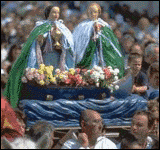Sarah
 |
May 23 is when the little town of Les Saintes-Maries-de-la-Mer begins to celebrate the festival of St. Sarah the Egyptian and the three Maries… (Mary Magdalene, Mary Jacobi and Mary Salomé) who allegedly arrived on the shore in “a boat with no oars” in c.AD 42…. apparently (according to French legend) bringing with them the Holy Grail and the “good news” of Christianity in their hearts (though it had yet to be written!) Interior of the shrine of Saintes-Maries-de-la-Mer |
The three saints Mary Magdalene, Mary Salome and Mary Jacobe, whose relics are the focus of the devotions of pilgrims, are believed to be the women who were the first witnesses to the empty tomb at the resurrection of Jesus. After the Crucifixion of Jesus, Mary Salome, Mary Jacobe, and Mary Magdalene set sail from Alexandria, Egypt with their uncle Joseph of Arimathea. According to a longstanding French legend, they either sailed to or were cast adrift - either way they arrived off the coast of what is now France, at "a sort of fortress named Oppidum-Râ". The location was known as Notre-Dame-de-Ratis (Râ becoming Ratis, or boat) (Droit, 1961, 19); the name was later changed to Notre-Dame-de-la-Mer, and then in 1838 to Les Saintes-Maries-de-la-Mer. | Saintes-Maries-de-la-Mer  |
Saint Sarah
From Wikipedia, the free encyclopedia
Saint Sarah, also known as Sara-la-Kali ("Sara the black", Romani: Sara e Kali), is the mythic patron saint of the Roma (Gypsy) people. The center of her veneration is Saintes-Maries-de-la-Mer, a place of pilgrimage for Roma in the Camargue, in southern France. Legend identifies her as the servant of one of the Three Marys, with whom she is supposed to have arrived in the Camargue.[1]
Contents[hide] |
[edit] Accounts
According to various legends, during a persecution of early Christians, commonly placed in the year 42, Lazarus, his sisters Mary Magdalene and Martha, Mary Salome (the mother of the Apostles John and James), Mary Jacobe and Saint Maximin were sent out to sea in a boat. They arrived safely on the southern shore of Gaul at the place later called Saintes-Maries-de-la-Mer. In some accounts Sarah, a native of Upper Egypt, appears as the black Egyptian maid of one of the Three Marys, usually Mary Jacobe.[2]
Though the tradition of the Three Marys arriving in France stems from the high Middle Ages, appearing for instance in the 13th century Golden Legend, Saint Sarah makes her first appearance in Vincent Philippon's book The Legend of the Saintes-Maries (1521), where she portrayed as "a charitable woman that helped people by collecting alms, which led to the popular belief that she was a Gypsy." Subsequently, Sarah was adopted by Roma as their saint.[3]
Another account has Sarah welcoming the Three Marys into Gaul. Franz de Ville (1956) writes:
One of our people who received the first Revelation was Sara the Kali. She was of noble birth and was chief of her tribe on the banks of the Rhône. She knew the secrets that had been transmitted to her... The Rom at that period practiced a polytheistic religion, and once a year they took out on their shoulders the statue of Ishtari (

